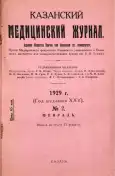Trichinosis and Nervous System Symptoms
- Authors: Khazanov M.A.1
-
Affiliations:
- Belarusian State University
- Issue: Vol 25, No 2 (1929)
- Pages: 187-192
- Section: Articles
- URL: https://journals.rcsi.science/kazanmedj/article/view/78848
- DOI: https://doi.org/10.17816/kazmj78848
- ID: 78848
Cite item
Full Text
Abstract
The works of Zenker'a, Virchow'a, Stäubli, Munk, Thager, Brown and others have adequately described the symptomatology, etiology, pathology and hemogram of trichinosis in humans. Comparatively, little attention was paid only to the phenomena of damage to the nervous system. Most of the authors are inclined to attribute a number of symptoms, such as the absence of tendon reflexes, electrical excitability disorder, Kernig's symptom, etc., due to exceptional muscle damage. Even severe cases of trichinosis with cerebral phenomena are interpreted by many authors (Trounner, Flurу, Nonne and Noerfner, etc.) as phenomena of a secondary order caused by the influence of toxic products. Meanwhile, the latest research by Gamrer and Gruber proved the presence of juvenile Trichinella in the meninges. In the cranial cavity under the dura mater they found copious amounts of fluid in which numerous juvenile Trichinella were found; they were also found in the pia mater and brain tissue. These data show that the nervous system is directly exposed to the invasion of Trichinella and a number of clinical phenomena are due exclusively to the damage to the nervous system. Already Stäubli, in his classic monograph on trichinosis, cites 2 cases in which meningeal phenomena prevailed at the onset of the disease, and which, in his opinion, were caused by "acute cerebral edema or hydrocephalus". His in some of his cases of trichinosis observed clonus of the foot and Babinsky's symptom. Matthes believes that the excruciating headaches, paresthesia and neuralgia of trichinosis depend on the damage to the nervous system. Decastello notes that the absence of tendon reflexes is due to a violation of the motor pathways of the nerve, system. The opinion of these authors is confirmed by the data of pathological and anatomical studies. Knorr found small meningo-encephalitic foci during the autopsy of one case of trichinosis, although the patient had no meningitis during her lifetime. Gamper and Gruber also found numerous degenerative and proliferative foci in the brain and membranes in one patient who died of trichinosis.
Keywords
Full Text
##article.viewOnOriginalSite##About the authors
M. A. Khazanov
Belarusian State University
Author for correspondence.
Email: info@eco-vector.com
Clinic assistant; clinic of nervous diseases
Belarus, MinskReferences
Supplementary files





